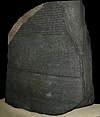The Rosetta Stone is part of an Ancient Egyptian granodiorite stele with engraved text that provided the key to modern understanding of Egyptian hieroglyphs. The inscription records a decree that was issued at Memphis in 196 BCE on behalf of King Ptolemy V. The decree appears in three texts: the upper one is in ancient Egyptian hieroglyphs, the middle one in Egyptian demotic script, and the lower text in ancient Greek. Originally displayed within a temple, the stele was probably moved during the early Christian or medieval period, and eventually used as building material in the construction of a fort at the town of Rashid (Rosetta) in the Nile delta. It was rediscovered there in 1799 by a soldier of the French expedition to Egypt. As the first known bilingual text, the Rosetta Stone aroused wide public interest with its potential to decipher the hitherto untranslated ancient Egyptian languages. Lithographic copies and plaster casts began circulating amongst European museums and scholars. Meanwhile, British troops defeated the French in Egypt in 1801, and the original stone came into British possession under the Capitulation of Alexandria. Transported to London, it has been on public display at the British Museum since 1802. It is the most-visited object in the British Museum. (more...)
Recently featured: Interstate 15 in Arizona – Symphony No. 8 (Mahler) – Roy of the Rovers
